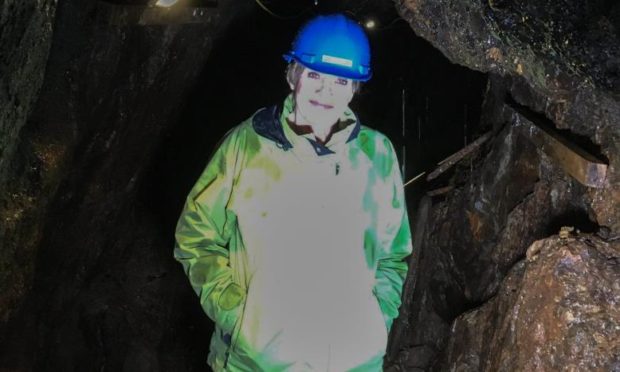I’ve been in the dark this week. Then my nearest and dearest would say that’s the case about most things these days…
Wanlockhead is Scotland’s highest village and nearby Leadhills is the second highest.
Both communities sit on miles of underground tunnels. And the clue’s in the name.
There in the Southern Upland hills are vast reserves of lead.
Centuries back it was a metal that was highly prized and used for a range of goods, from glass to ammunition, paint to pipes,
And so, I find myself donning a hard hat and preparing to brave it.
Crouching low as we follow the twists and turns of the darkened passages. Blackened seams to either side of us. Water dripping on our backs.
We are filming at the Museum of Lead Mining. And that means a tour of the visitor centre, before tackling an old mine.
It is one that was hewn out of the rock 300 years ago. And it is on the worst possible day.
‘My grandfather was a coal miner’
Above us the wind howls, and the heavens are emptying.
‘Welcome to summer in the Lowther Hills!’ our guide jokes as we prepare to go inside.
Mine is a mix of excitement and fear. But why be scared? For us, this job should be easy.
My grandfather was a coal miner from west Cumbria. The cameraman’s grandad was a miner from the north-east.
Mining’s in the blood. But wooden props creak as we tread warily. Cold and damp seep into bones and boots.
A reminder of brutally hard work
And there, a quarter of a mile in, right at the end, is the cavern. Where, back in the day, hardy men hacked away.
It must have been brutal. Working with bare legs. Flimsy felt hats on fragile heads.
A candle for light. Trying to source the galena that contains the precious veins of lead
Once hewn, the stone would be dragged to the surface on small barrows, usually by the children.
Child labour lasted a few decades. When a school opened up and they had to be in the classroom, a large metal cart was employed to do the job instead.
Scotland’s first subscription library
Conditions were primitive. Yet it is said that local youngsters could read and write.
The reason – Leadhills boasts Scotland’s first subscription library; part funded in 1741 by miners who wanted to read.
Some years later Wanlockhead followed suit and became the second place in the country to get a library.
This village is an intriguing place. And it’s one the modern world does not seem to have caught up with.
A few descendants of miners still live there, and if the cottages are increasingly home to incomers, the community spirit remains strong.
The MacNaughties know I’ve been somewhere interesting. I get home buoyed. I have done something brave – even if my new green jacket is marked with mud.
In it goes into the washing machine whilst over supper the talk turns to mines.
Would I go back? Yes – and if you’re passing, and of a curious nature, it is certainly worth a visit!




